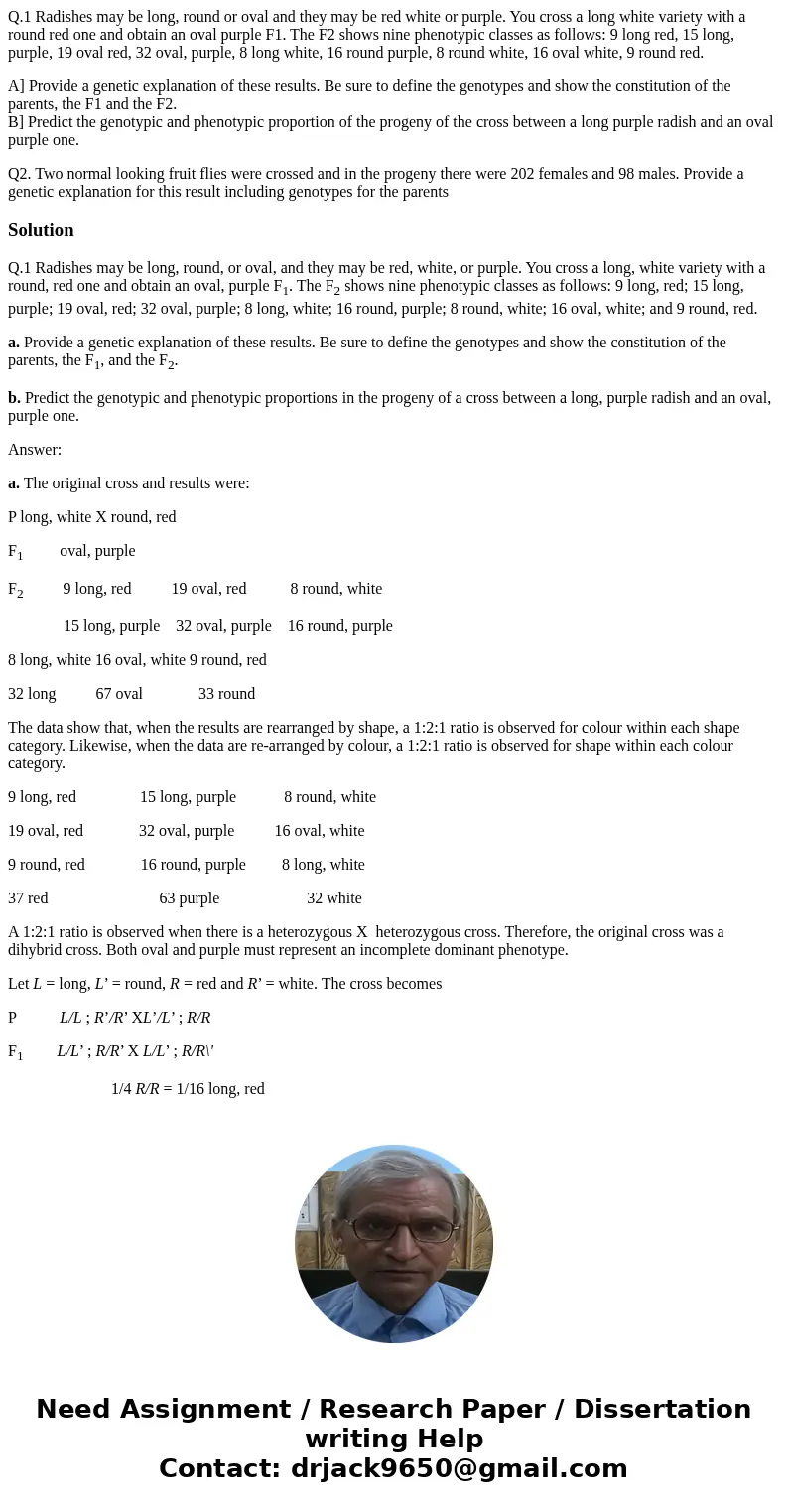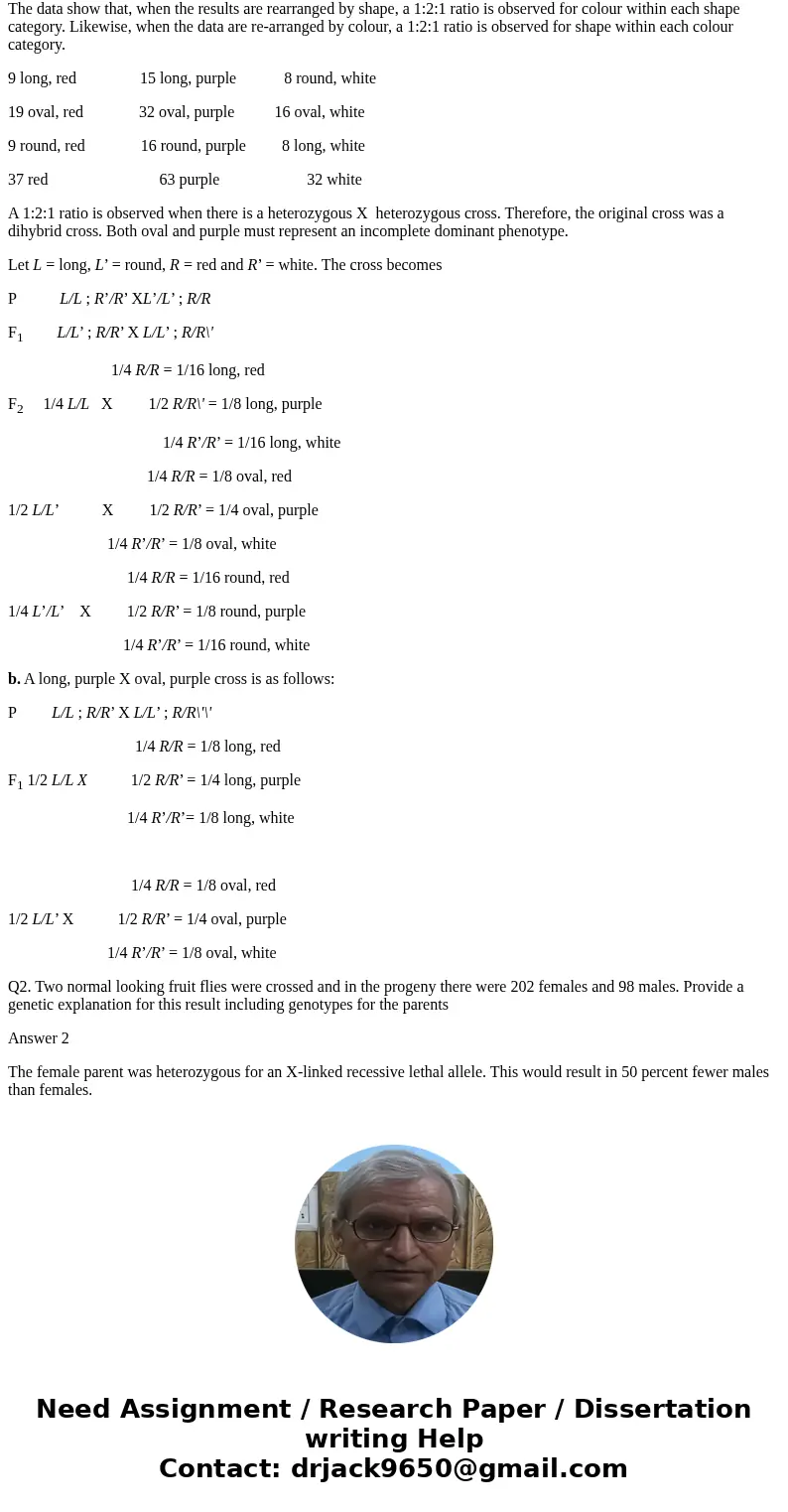Q1 Radishes may be long round or oval and they may be red wh
Q.1 Radishes may be long, round or oval and they may be red white or purple. You cross a long white variety with a round red one and obtain an oval purple F1. The F2 shows nine phenotypic classes as follows: 9 long red, 15 long, purple, 19 oval red, 32 oval, purple, 8 long white, 16 round purple, 8 round white, 16 oval white, 9 round red.
A] Provide a genetic explanation of these results. Be sure to define the genotypes and show the constitution of the parents, the F1 and the F2.
B] Predict the genotypic and phenotypic proportion of the progeny of the cross between a long purple radish and an oval purple one.
Q2. Two normal looking fruit flies were crossed and in the progeny there were 202 females and 98 males. Provide a genetic explanation for this result including genotypes for the parents
Solution
Q.1 Radishes may be long, round, or oval, and they may be red, white, or purple. You cross a long, white variety with a round, red one and obtain an oval, purple F1. The F2 shows nine phenotypic classes as follows: 9 long, red; 15 long, purple; 19 oval, red; 32 oval, purple; 8 long, white; 16 round, purple; 8 round, white; 16 oval, white; and 9 round, red.
a. Provide a genetic explanation of these results. Be sure to define the genotypes and show the constitution of the parents, the F1, and the F2.
b. Predict the genotypic and phenotypic proportions in the progeny of a cross between a long, purple radish and an oval, purple one.
Answer:
a. The original cross and results were:
P long, white X round, red
F1 oval, purple
F2 9 long, red 19 oval, red 8 round, white
15 long, purple 32 oval, purple 16 round, purple
8 long, white 16 oval, white 9 round, red
32 long 67 oval 33 round
The data show that, when the results are rearranged by shape, a 1:2:1 ratio is observed for colour within each shape category. Likewise, when the data are re-arranged by colour, a 1:2:1 ratio is observed for shape within each colour category.
9 long, red 15 long, purple 8 round, white
19 oval, red 32 oval, purple 16 oval, white
9 round, red 16 round, purple 8 long, white
37 red 63 purple 32 white
A 1:2:1 ratio is observed when there is a heterozygous X heterozygous cross. Therefore, the original cross was a dihybrid cross. Both oval and purple must represent an incomplete dominant phenotype.
Let L = long, L’ = round, R = red and R’ = white. The cross becomes
P L/L ; R’/R’ XL’/L’ ; R/R
F1 L/L’ ; R/R’ X L/L’ ; R/R\'
1/4 R/R = 1/16 long, red
F2 1/4 L/L X 1/2 R/R\' = 1/8 long, purple
1/4 R’/R’ = 1/16 long, white
1/4 R/R = 1/8 oval, red
1/2 L/L’ X 1/2 R/R’ = 1/4 oval, purple
1/4 R’/R’ = 1/8 oval, white
1/4 R/R = 1/16 round, red
1/4 L’/L’ X 1/2 R/R’ = 1/8 round, purple
1/4 R’/R’ = 1/16 round, white
b. A long, purple X oval, purple cross is as follows:
P L/L ; R/R’ X L/L’ ; R/R\'\'
1/4 R/R = 1/8 long, red
F1 1/2 L/L X 1/2 R/R’ = 1/4 long, purple
1/4 R’/R’= 1/8 long, white
1/4 R/R = 1/8 oval, red
1/2 L/L’ X 1/2 R/R’ = 1/4 oval, purple
1/4 R’/R’ = 1/8 oval, white
Q2. Two normal looking fruit flies were crossed and in the progeny there were 202 females and 98 males. Provide a genetic explanation for this result including genotypes for the parents
Answer 2
The female parent was heterozygous for an X-linked recessive lethal allele. This would result in 50 percent fewer males than females.


 Homework Sourse
Homework Sourse